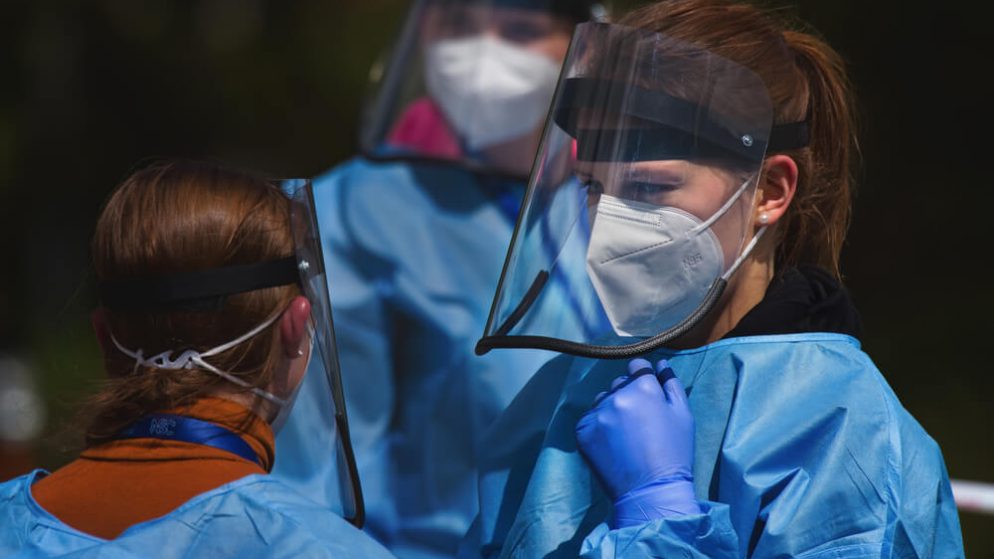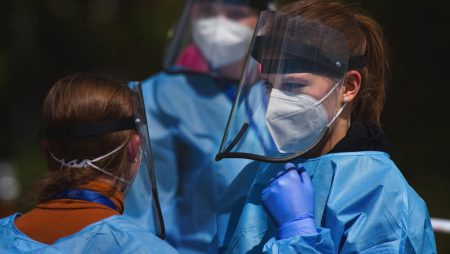



Get new exclusive access to healthcare business reports & breaking news




The Trump administration introduced a loan forgiveness plan for students in the early stages of the pandemic. The Biden administration extended the program, which is due to end on October 1, 2021. Several requirements must be met to fully qualify for the loan payment relief. Although there is no specific type of loan forgiveness aimed at frontline workers in healthcare or first responders, there is a bit of good news on that matter. There are a few options available and depending on the qualifications a healthcare worker or first responder can meet, they may be able to apply for student loan forgiveness.
This is the best solution for frontline healthcare workers. According to the Wall Street Journal, the program provides complete forgiveness of a student loan to frontline healthcare workers after they have made 120 qualifying payments. In other words, the borrower must make on-time, full amount payments for 120 months under an income-driven repayment plan. As soon as this threshold is met, the remaining debt is forgiven. To apply for this program, healthcare workers providing public service as either full-time (at least 30 hours a week) or part-time (with a combined total of at least 30 hours a week from two or more jobs) are eligible. The applicant must be working for an eligible employer during both the application phase and during the repayment period. This loan forgiveness program for healthcare workers is not taxable which removes a huge income tax requirement from borrowers who receive the loan forgiveness.
The Public Service Loan Forgiveness (PSLF) Program covers just Direct Loans. Consolidating loans as a Direct Consolidation Loan may be eligible for the forgiveness program but there is a hitch. The loan repayments before consolidation will not count towards the 120-month repayment requirement. Plus, FFEL, private or Perkins loans do not qualify. To apply, borrowers are advised to fill out a PSLF form and submit one periodically during the 120 payment period. The purpose of this is to provide loan services an opportunity to monitor the progress of repayments and to provide the borrower with information related to the number of qualifying payments. Without submitting a PSLF form and employment certificate regularly, the borrower will otherwise have to provide a series of forms at the time of application. By doing this frequently during the payment period, the required information is already on file. It is pertinent to meet all requirements to receive student loan forgiveness. This includes completing 120 qualifying payments and any additional eligibility requirements.
A Bill was introduced in May 2020. Congresswoman Carolyn Maloney, the representative for the 12th congressional district of New York, introduced it as she believed that frontline healthcare workers who had made significant contributions to their industry during the pandemic should be recognized. That is why, per the New York Times, the bill had a provision to forgive student loan debt being carried by healthcare workers. Maloney argued that since many people had no choice but to stay home to be safe, the frontline workers were risking their lives to save those of others. It was because of this dedication and commitment to healthcare that Maloney felt that the last thing frontline healthcare workers needed to be concerned about was their financial challenges and student loan debt. That was the incentive she used to introduce the bill to enforce student loan forgiveness for frontline workers.
Maloney’s initial bill was a two-parter. One part focused on the federal student loan forgiveness program which provided forgiveness on both the interest and the principal debt amount for loans that were eligible for the program. Eligibility included loans with parts B, D, and E of Title IV of the Higher Education Act. That meant that Perkins, Federal PLUS, Direct and consolidated were all eligible. Also, the forgiveness amount would not be taxable. The bill for student loan forgiveness for frontline workers also acknowledged private student loans but did not forgive them. Instead, a repayment plan put the responsibility on the Secretary to repay the private loan in full, including interest and principal. For a private loan to qualify, it had to be for educational purposes at eligible educational institutions. Those qualifying schools would also have to be eligible to participate in the federal student loan program. The repayment plan would not cover refunds and would not be taxable.
Congresswoman Maloney’s proposed bill covered a large cross-section of frontline healthcare workers. This list included doctors, nurses, interns, residents, lab techs, and several other healthcare providers who could apply for student loan forgiveness under this bill. Sadly, the bill did not pass. It had a focus on fairness for frontline healthcare workers but did not receive enough votes. As a result, the bill was rejected. However, it has since been reintroduced in April 2021 and has received endorsements from:
– the Association of American Medical Colleges
– the Nurse-Family Partnership
– The New York State Nurses Association (plus several other nurses associations)
– American Federation of Teachers
The most logical other option available for healthcare workers seeking student loan forgiveness is the payment pause and interest waiver program as reported by the Washington Post. This is the program noted above that will end on October 1, 2021. It is only for federal student loans owned by the Department of Education. Then there is the Opportunities for Heroes Act of 2020. This was introduced in the US House of Representatives by Rep. Anne Kuster of New Hampshire and Rep. Brian Fitzpatrick of Pennsylvania. The bill would provide up to $25,000 in student loan forgiveness for federal and private student loans of a borrower who is an essential worker. The bill did not pass, but it may resurface. The Public Health Workforce Loan Repayment Act of 2020 was introduced in the House by Colorado Rep. Jason Crow. This plan was to provide student loan forgiveness of up to $105,000 for federal and private student loans. The borrower had to have a public health or health professional degree or certificate and had accepted a job or was already working for a local, State, or Tribal public health agency. The borrower had to be a US citizen. The law was designed to give the borrower three-year forgiveness in exchange for working for a qualified public health agency. There were additional qualifications to be met but this bill also died on the congressional floor.
Well, there is always the option of refinancing. This is an attractive choice simply because interest rates are at an all-time low and borrowers who refinance now could potentially save thousands of dollars in interest. However, if you are a frontline healthcare worker considering refinancing your student loan, keep in mind that if it happens to be a federal student loan, you cannot refinance it into another federal student loan. This means that if you have a federal student loan, it can only be refinanced into a private student loan and once that happens, you will lose several federal benefits such as:
– COVID-19 relief payment pause and interest waiver
– Income-driven options for repayment
– Public Student Loan Forgiveness eligibility
– options for deferment
Going Back To School
Even if you are not eligible for a student loan forgiveness program, this may be the time to consider going back to school. That is because while you are in school, repaying your loans is put on hold. Student loan marketplaces like Earnest offer affordable loan options by looking at your profile and the best available options on the market today. And who has thought that furthering your education was a bad plan? By going back to school you are investing in your future.
You can’t say that student loan forgiveness for healthcare workers is not a consideration during COVID times. If it weren’t for the dedicated doctors, nurses, residents, interns, first responders, lab tech, and all other healthcare professionals, imagine where we would be now? Instead of seeing things slowly reopen and COVID protocols getting peeled back, we have all of these healthcare workers to thank. They have risked their lives to protect ours in a pandemic that took the world by surprise. You would think that student loan forgiveness for healthcare workers would be the least we could do to show our appreciation. Well, there have been attempts to achieve this, but most of the bills introduced in the House have not been passed into law. So there remain few options. If the student loan taken out by a healthcare worker is a federal loan, it is eligible for the current COVID-19 relief payment pause and interest waiver that has been in place for over a year and a half and is due to end October 1. There is the Public Service Loan Forgiveness Program, but it has many qualifications that must be met. Aside from refinancing that loan at today’s low-interest rates or going back to school, there are not a lot of ways where student loan forgiveness for healthcare workers is going to happen. However, failed bills can be reintroduced and in time, that could be the solution.